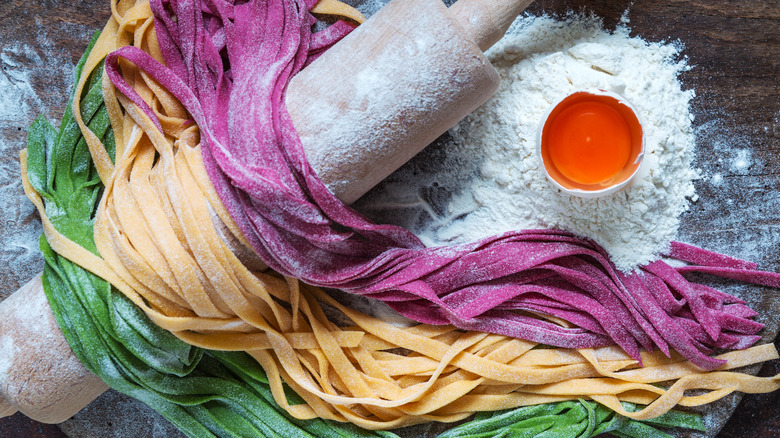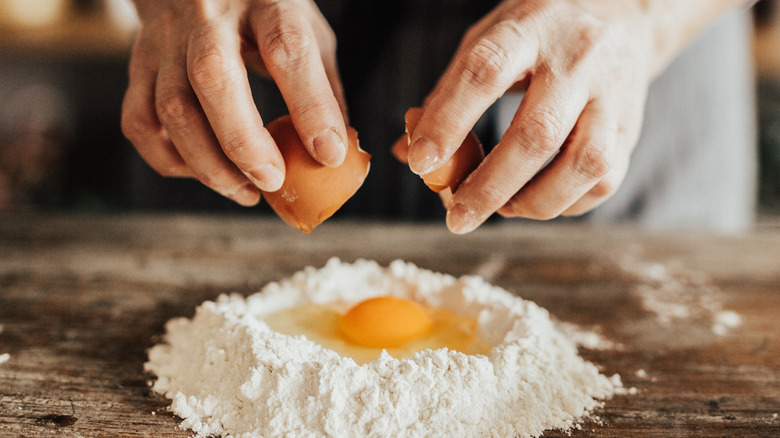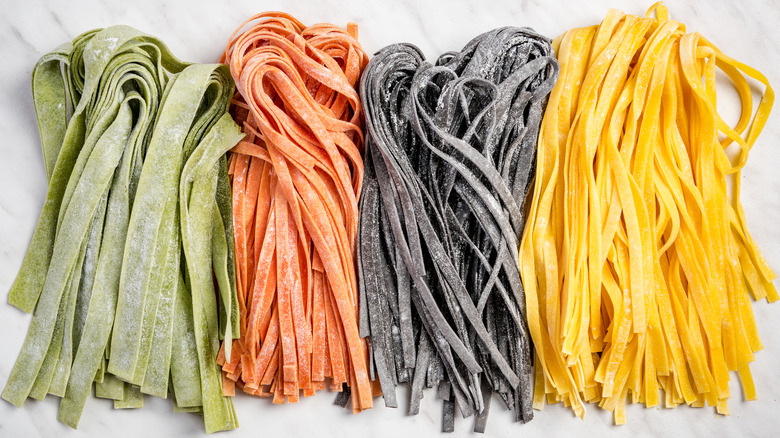How To Properly Add A Pop Of Color To Your Homemade Pasta
Making homemade pasta is a labor of love. From kneading the dough to shaping the noodles just right, it's a time-intensive process that yields endless possibilities. But sometimes, even with all that effort, the final result can look a bit plain. In that case, adding a pop of color can spice things up a bit (sometimes literally).
The secret to achieving an eye-catching effect is to mix puréed vegetables into the dough as you knead it all together (just don't use regular flour; it's the worst for sticky, fresh pasta). Not only does this technique create vibrant hues ranging from pale green to deep red, but it also adds flavor and nutrition to your pasta.
You can use vegetables such as spinach, beetroot, or carrots to make your veggie purée, but everything from bell peppers and pumpkin to cabbage works, too. Adam Berger, who previously worked at Michelin-starred restaurants in Piedmont and Tuscany, and now makes fresh pasta daily at Montelupo Italian Market and Rallenti Pasta in Portland, told Insider, "I really like blanched, shocked, and pureed nettles for a vibrant green color."
The best part? You don't have to be a seasoned pasta maker to perfect this technique. With these simple steps, you can achieve the perfect texture and color. You'll be whipping up delicious recipes that'll inspire creativity in the kitchen in no time.
How to add color to pasta
Whether you're looking to impress your dinner guests or just want to add some visual appeal to your plate, there are several ways you can add vibrant colors to your pasta. While adding food coloring or even fruit or vegetable juice might seem like the most convenient way to achieve colorful pasta, true culinary aficionados know that adding real vegetables is always a tastier option.
According to Philips, the most effective and easiest way to add color to your pasta is by making vegetable purée. By blending vegetables such as spinach, beets, or bell peppers with eggs and salt in a blender, you can create a purée that will not only add color to your pasta but also infuse it with a natural, earthy flavor. Of course, to make the purée, you'll need to boil or roast the veggies beforehand to ensure they're tender and easy to dice. Once you have the veggie mix ready, knead it into the dough and cut your pasta into your desired shapes.
If you don't have any veggies on hand, another solution is to rely on colorful spices like turmeric or leftover herbs like parsley to alter the final color of the pasta — a dash of turmeric with a boiled red pepper will yield a bright, orange-colored pasta perfect for fall holidays.
The best veggies to use for colored pasta
Beets are one of the most popular ingredients for creating bright magenta pasta. They have a sweet, earthy flavor that pairs well with a range of toppings. Spinach and kale are perfect for creating a green color that is both appetizing and nutritious, packed with antioxidants and vitamins. Carrots and pumpkin also provide a beautiful orange hue with a slightly sweet taste, making them a more playful alternative to tomato-based sauces.
For a more daring hue and unique taste, try using red cabbage or blueberries. Red cabbage can give your pasta a beautiful blue or purple color, but beware, the color may fade during cooking. Blueberries, on the other hand, can add a deep blue tone with a fruity taste that complements cheese and cream-based sauces.
When using vegetables for colored pasta, remember that the texture will change based on the ingredient used. That's why it's best to cook the vegetables before adding them to the noodles, as it will help extract the maximum pigment and soften their consistency. With these options at hand, you can create an entire colorful pasta menu that is both visually stunning and nutritious.


